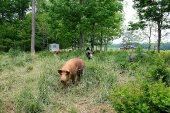I have recently joined this forum and am really thankful for it. Getting lots of good info. I have 17 acres in Upstate South Carolina. Most is wooded and thickets, but we have a small, 2 acre field. I want to raise pigs, especially because we have a lot of white oaks that drop prodigious amounts of acorns every year. That may be partly due to the fact that they are around the leach field for our septic. I harvest some of them for flour, they are quite tasty and only need a few
water changes for the leaching process over a couple of days. But pigs would help us eat the rest. I am trying to figure out how to
feed them through the winter as well. We have somewhat mild winters, but nightly frosts and very rare snows. I want to plant buckwheat as a nurse cover to protect the cold loving forage plants from the late summer heat, and maybe provide organic matter to insulate them when frosts hit some time in October/November. The main forage crops would be winter rye, crimson clover, fava beans, beets and brassicas, but the soil is compacted clay and only grows a few grasses and wild plants. I cannot till it at all, or it will turn to
concrete and not even grow that. I have thought of a few ideas so far, but need some help.
1. I could sheet mulch, but would need
enough soil added to the top to start the seeds in. I have a wheelbarrow or two of
compost ready, but it is very rich, containing aged
chicken manure from our laying hens. I don't want to dig soil from somewhere else, because I would then turn that area into concrete. But I don't want to have to buy topsoil at Lowe's either. Maybe a scoop of mulch from the
local feed store?
2. I could try to loosen it with a spade fork and drop seeds in the cracks, sprinkled with a little compost, but I doubt I could cover enough area in time to grow much. We have a
tractor, but just a bush hog and box scraper to go with it. The box scraper has wide, blunt teeth on it that can be lowered below the box. I do not know if it could be used to rip the ground, maybe just one pass, without doing too much damage (i.e. causing hardpan).
3. Seed Balls? Don't know enough about the
Fukuoka method, but a little research wouldn't hurt.
I eventually want to add strips of forage/orchard
trees interplanted with
black locust, strategically placed where the fruit in season would drop into the proper paddock. The paddocks will include the edge of the woods/thickets bordering the field by bush hogging fencelines. Trees would include mulberry, pawpaw, persimmons, apples, pecans and chinkapin oaks. Maybe figs as well. But, same problem with the soil. Would appreciate any helpful info. Thanks in advance!
-Sara

























